初中英语时态讲解(完整版)
初中英语语法八大时态总结(完整版)
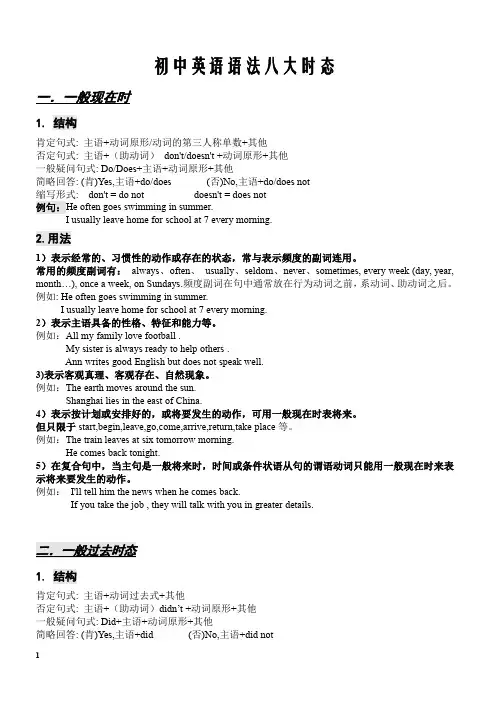
初中英语语法八大时态一.一般现在时1.结构肯定句式:主语+动词原形/动词的第三人称单数+其他否定句式:主语+(助动词)don't/doesn't+动词原形+其他一般疑问句式:Do/Does+主语+动词原形+其他简略回答:(肯)Yes,主语+do/does(否)No,主语+do/does not缩写形式:don't=do not doesn't=does not例句:He often goes swimming in summer.I usually leave home for school at7every morning.2.用法1)表示经常的、习惯性的动作或存在的状态,常与表示频度的副词连用。
常用的频度副词有:always、often、usually、seldom、never、sometimes,every week(day,year, month…),once a week,on Sundays.频度副词在句中通常放在行为动词之前,系动词、助动词之后。
例如:He often goes swimming in summer.I usually leave home for school at7every morning.2)表示主语具备的性格、特征和能力等。
例如:All my family love football.My sister is always ready to help others.Ann writes good English but does not speak well.3)表示客观真理、客观存在、自然现象。
例如:The earth moves around the sun.Shanghai lies in the east of China.4)表示按计划或安排好的,或将要发生的动作,可用一般现在时表将来。
但只限于start,begin,leave,go,come,arrive,return,take place等。
初一英语四种时态讲解
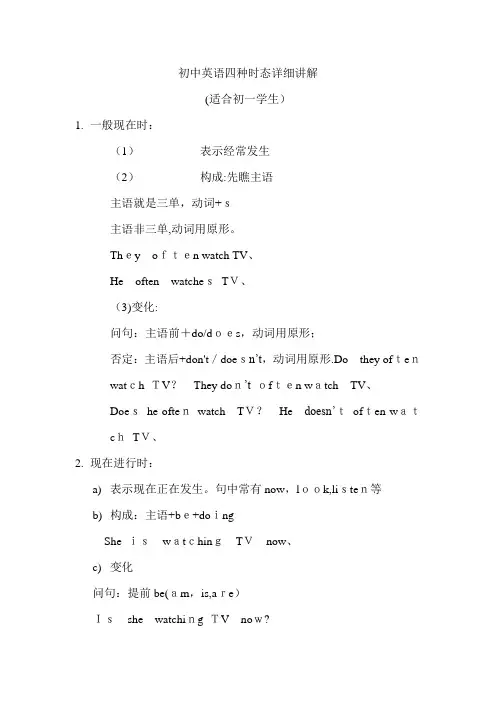
初中英语四种时态详细讲解(适合初一学生)1.一般现在时:(1)表示经常发生(2)构成:先瞧主语主语就是三单,动词+s主语非三单,动词用原形。
They often watch TV、He often watchesTV、(3)变化:问句:主语前+do/does,动词用原形;否定:主语后+don't/doesn’t,动词用原形.Do they oftenwatch TV?They don’t often watch TV、Doeshe oftenwatch TV?He doesn’toften watchTV、2.现在进行时:a)表示现在正在发生。
句中常有now,look,listen等b)构成:主语+be+doingShe iswatchingTVnow、c)变化问句:提前be(am,is,are)Isshe watching TV now?否定:be后+notSheisn'twatching TV now、d)加ing得方法:一般直接+,去不发音得e加,闭音节双写+。
3.一般过去时:a)表示过去得动作或状态,句中常有yesterday,last等过去得时间。
b)构成:动作:主语+动词得过去式状态:主语+was/were(句中没实意动词)Shewatched TV last night、She was herelast night、c)变化:问句:主语前+did,动词用原形DidshewatchTV last night?Was she here lastnight?否定:主语后+didn’t,动词用原形.She didn’twatch TV lastnight、She wasn’t watch TV last night、(4)过去式:一般+ed;e结尾+d;辅音+y得,去y+ied;闭音节双写+ed;不规则得120页。
4.一般将来时:a)表示:将来,句中有表示将来得时间:tomorrow、next、soon,intwo days等b)构成A:主语+will+do(任何人称)B:主语+shall+do(仅第一人称I,we)C:主语+be going to +do 如:A:Shewillwatch TV this evening、B:Weshallwatch TV this evening、C:She is going to watch TV this evening、c)变化问句:提前will/shall/beA:Will she watch TV this…?B:ShallwewatchTV …?C:Isshe going towatch…?否定:在will/shall/be 后+notA: She won't watch TV…B:We shall notwatch…shan'tC:She isn’t going to watch…There is a meeting next week、Therewas a meetingyesterday、There will be a meeting next…=Thereisgoing tobeameeting next …。
初中英语五种时态讲解
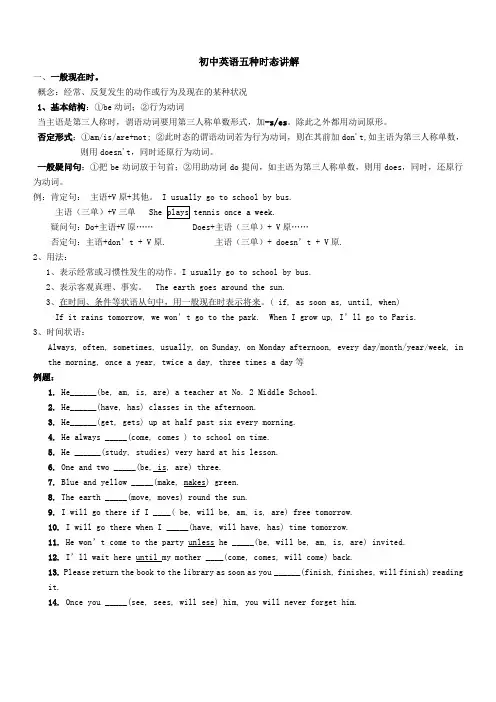
初中英语五种时态讲解一、一般现在时。
概念:经常、反复发生的动作或行为及现在的某种状况1、基本结构:①be动词;②行为动词当主语是第三人称时,谓语动词要用第三人称单数形式,加-s/es。
除此之外都用动词原形。
否定形式:①am/is/are+not; ②此时态的谓语动词若为行为动词,则在其前加don't,如主语为第三人称单数,则用doesn't,同时还原行为动词。
一般疑问句:①把be动词放于句首;②用助动词do提问,如主语为第三人称单数,则用does,同时,还原行为动词。
例:肯定句:主语+V原+其他。
I usually go to school by bus.主语(三单)+V三单疑问句:Do+主语+V原…… Does+主语(三单)+ V原……否定句:主语+don’t + V原. 主语(三单)+ doesn’t + V原.2、用法:1、表示经常或习惯性发生的动作。
I usually go to school by bus.2、表示客观真理、事实。
The earth goes around the sun.3、在时间、条件等状语从句中,用一般现在时表示将来。
( if, as soon as, until, when)If it rains tomorrow, we won’t go to the park. When I grow up, I’ll go to Paris.3、时间状语:Always, often, sometimes, usually, on Sunday, on Monday afternoon, every day/month/year/week, in the morning, once a year, twice a day, three times a day等例题:1. He______(be, am, is, are) a teacher at No. 2 Middle School.2. He______(have, has) classes in the afternoon.3. He______(get, gets) up at half past six every morning.4. He always _____(come, comes ) to school on time.5. He ______(study, studies) very hard at his lesson.6. One and two _____(be, is, are) three.7. Blue and yellow _____(make, makes) green.8. The earth _____(move, moves) round the sun.9. I will go there if I ____( be, will be, am, is, are) free tomorrow.10. I will go there when I _____(have, will have, has) time tomorrow.11. He won’t come to the party unless he _____(be, will be, am, is, are) invited.12. I’l l wait here until my mother ____(come, comes, will come) back.13. Please return the book to the library as soon as you ______(finish, finishes, will finish) readingit.14. Once you _____(see, sees, will see) him, you will never forget him.⑵一般过去时。
初中英语时态8种基本时态讲解
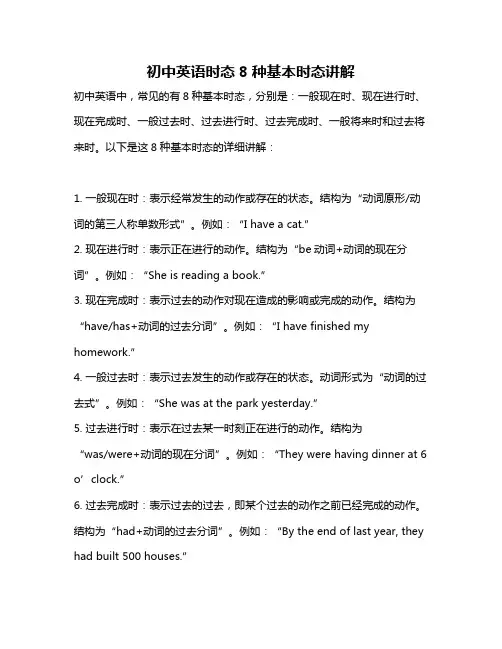
初中英语时态8种基本时态讲解初中英语中,常见的有8种基本时态,分别是:一般现在时、现在进行时、现在完成时、一般过去时、过去进行时、过去完成时、一般将来时和过去将来时。
以下是这8种基本时态的详细讲解:1. 一般现在时:表示经常发生的动作或存在的状态。
结构为“动词原形/动词的第三人称单数形式”。
例如:“I have a cat.”2. 现在进行时:表示正在进行的动作。
结构为“be动词+动词的现在分词”。
例如:“She is reading a book.”3. 现在完成时:表示过去的动作对现在造成的影响或完成的动作。
结构为“have/has+动词的过去分词”。
例如:“I have finished my homework.”4. 一般过去时:表示过去发生的动作或存在的状态。
动词形式为“动词的过去式”。
例如:“She was at the park yesterday.”5. 过去进行时:表示在过去某一时刻正在进行的动作。
结构为“was/were+动词的现在分词”。
例如:“They were having dinner at 6 o’clock.”6. 过去完成时:表示过去的过去,即某个过去的动作之前已经完成的动作。
结构为“had+动词的过去分词”。
例如:“By the end of last year, they had built 500 houses.”7. 一般将来时:表示将来要发生的动作或存在的状态。
结构为“will+动词原形”或“am/is/are going to+动词原形”。
例如:“We will visit the museum next week.”8. 过去将来时:表示从过去的某一时刻看,将来要发生的动作或存在的状态。
结构为“would+动词原形”或“was/were going to+动词原形”。
例如:“He said he would come back soon.”以上就是初中英语8种基本时态的讲解,希望对你有帮助!。
(详细)初中九大时态讲解
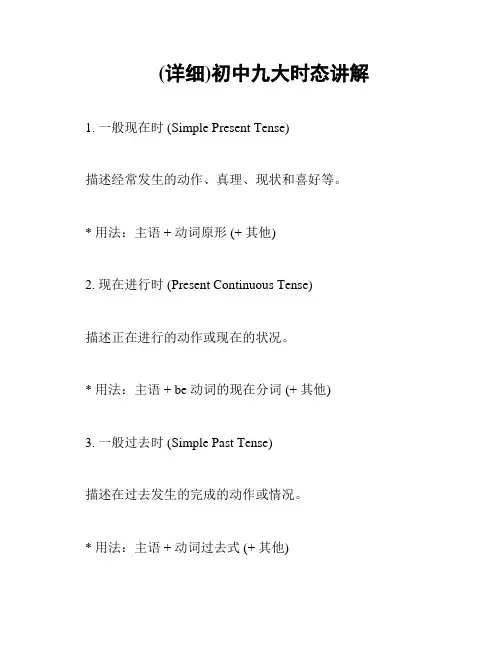
(详细)初中九大时态讲解1. 一般现在时 (Simple Present Tense)描述经常发生的动作、真理、现状和喜好等。
* 用法:主语 + 动词原形 (+ 其他)2. 现在进行时 (Present Continuous Tense)描述正在进行的动作或现在的状况。
* 用法:主语 + be 动词的现在分词 (+ 其他)3. 一般过去时 (Simple Past Tense)描述在过去发生的完成的动作或情况。
* 用法:主语 + 动词过去式 (+ 其他)4. 过去进行时 (Past Continuous Tense)描述在过去某个时间正在进行的动作。
* 用法:主语 + be 动词的过去分词 (+ 其他)5. 一般将来时 (Simple Future Tense)描述将来要发生的动作或情况。
* 用法:主语 + will/shall + 动词原形 (+ 其他)6. 将来进行时 (Future Continuous Tense)描述在某个将来时间正在进行的动作。
* 用法:主语 + will/shall + be + 动词的现在分词 (+ 其他) 7. 现在完成时 (Present Perfect Tense)描述发生在过去但对现在有影响的动作或情况。
* 用法:主语 + have/has + 动词过去分词 (+ 其他)8. 过去完成时 (Past Perfect Tense)描述在过去某个时间或发生的动作或情况。
* 用法:主语 + had + 动词过去分词 (+ 其他)9. 将来完成时 (Future Perfect Tense)描述在某个将来时间之前将要完成的动作或情况。
* 用法:主语 + will/shall + have + 动词过去分词 (+ 其他)在研究和掌握这九大时态时,可以通过大量的练和实践来加深理解和记忆。
希望本文档对您有所帮助!参考资料:。
初中英语语法八大时态总结(完整版)
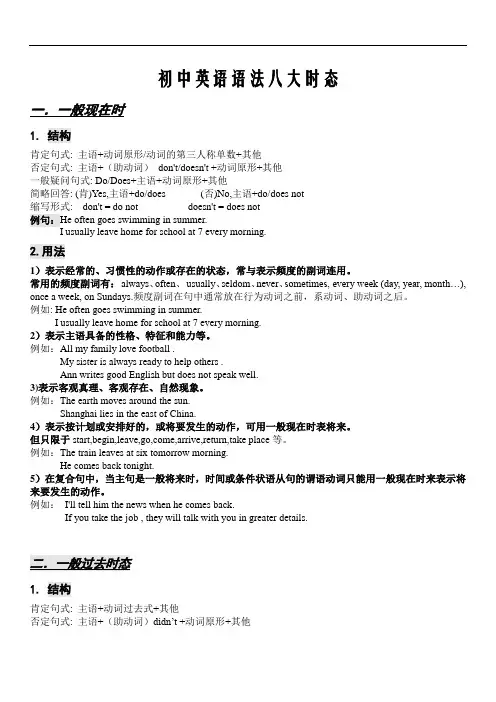
初中英语语法八大时态一.一般现在时1.结构肯定句式: 主语+动词原形/动词的第三人称单数+其他否定句式: 主语+(助动词)don't/doesn't +动词原形+其他一般疑问句式: Do/Does+主语+动词原形+其他简略回答: (肯)Yes,主语+do/does (否)No,主语+do/does not缩写形式: don't = do not doesn't = does not例句:He often goes swimming in summer.I usually leave home for school at 7 every morning.2.用法1)表示经常的、习惯性的动作或存在的状态,常与表示频度的副词连用。
常用的频度副词有:always、often、usually、seldom、never、sometimes, every week (day, year, month…), once a week, on Sundays.频度副词在句中通常放在行为动词之前,系动词、助动词之后。
例如: He often goes swimming in summer.I usually leave home for school at 7 every morning.2)表示主语具备的性格、特征和能力等。
例如:All my family love football .My sister is always ready to help others .Ann writes good English but does not speak well.3)表示客观真理、客观存在、自然现象。
例如:The earth moves around the sun.Shanghai lies in the east of China.4)表示按计划或安排好的,或将要发生的动作,可用一般现在时表将来。
初中英语时态讲解及练习(全)
时间状语:Tomorrow, next day(week, month, year…),soon, in a few minutes, by…,the day after tomorrow, etc.
否定形式:主语+am/is/are not going to do ; 主语+will/shall not do+其他 一般疑问句:be放于句首;will/shall提到句首。
1.I ____(write, am writing, is writing, are writing) a letter now. 2.Look, it _____(begin, is beginning, am beginning, are beginning) to rain. 3.They ____(study, is studying, am studying, are studying) medicine at the Medical Institute of Chengde these days. 4.He _____(teach, am teaching, is teaching, are teaching) an English lesson at this time.
谓语动词使用过去式形式, 加ed,分为规则和不规则变 化。表示过去经常发生的动 作,也可用“used to do ” 和“would +动词原形”。
1. He____(be, was, were, been) here a moment ago. 2. They ____(be, was, were, been) here just now. 3. The scientists _____(leave, leaves, leaved, left) for America yesterday. 4. Last week we ______(visit, visited ) the Science Museum. 5. When I was a child, I often ____(play, played) football. 6. The students ran out of the classroom as soon as the bell ____(ring, rang, rung).
初中英语八种时态详解
初中英语八种时态详解一.一般现在时一.要点提示一般现在时主要用动词原形表示,但是当主语是第三人称单数或者单数名词时,动词的形式要发生变化,其变化规律是:1. 一般动词后加-s, 如:wears, reads, plays, likes, 2.以s, x, ch, sh结尾,后加-es, 如:watches, brushes, 3.以辅音字母+o结尾,一般加-es, 如:goes, does, 4.辅音字母+y 结尾,变y为i,再加-es, 如:worries, carries. Be动词一般现在时的特殊形态是:am, is, are。
Have的第三人称单数是has。
二.用法指南一般现在时的用法1) 表示经常性或习惯性的动作,常与表示频度的时间状语连用。
时间状语:always总是, often经常,usually通常, seldom很少, never从不, sometimes有时(以上频度副词位置放于行为动词之前), every…每…(放于句首或者句末均可)I leave home for school at 7 every morning.It often snows here.2) 表示现在的状态、特征、能力、性格等。
I know him very well.Ann Wang writes good English but does not speak well.3) 表示格言或警句中。
Pride goes before a fall. 骄者必败。
Failure is the mother of success. 失败是成功之母。
4) 表示客观真理,客观存在,科学事实。
The earth moves around the sun.Shanghai lies in the east of China.三. 一般现在时态的肯定形式,否定形式及疑问形式肯定形式是用动词原形,be动词用am, is, are, 注:动词的第三人称单数形式的变化;否定形式是在be动词后加否定词not(缩写成isn’t, aren’t, am与not不能缩写),或者添加助动词do/does加not再加动词原形(缩写成don’t/doesn’t).疑问形式是把be动词或助动词do/does提置句首, 动词还原,句末问号,人称上第一人称变第二人称,第二人称变第一人称,第三人称不变。
初中英语:八大时态讲解
英语八大时态:一、一般现在时1.表示经常性或习惯性动作,常与表频度的时间状语连用:She often speaks English。
I leave home for school at 7 every morning.造句练习:孩子们通常不喜欢家庭作业.2.表示现在的状态、特征、职业、能力、感觉等:He seems to feel a bit down today。
He works as a driver。
造句练习:她英语说得好。
3.表示真理、客观存在、科学事实或用于格言警句中:Shanghai lies in the east of China。
Columbus proved that the earth is round。
Where there is a will,there is a way。
造句练习:地球绕太阳转动.4.表示现在瞬间的动作:Here comes the bus!5.表示将来1)表按规定、计划、安排将要发生的动作(仅限于某些表示“来、去、动、停、开始、结束、继续”等的趋向动词),可以与表示未来的时间状语搭配使用。
常见的用法是:飞机、火车、轮船、汽车等定期定点运行的交通状况。
如:The next train leaves at 3 o’clock this afternoon.How often does the shuttle bus run?2)在时间和条件状语从句中常使用一般现在时表示将来发生的事情:When Bill comes (不用will come), ask him to wait for me。
I shall go there tomorrow unless I’m too busy。
【练习题】①Nowadays, a large number of women,especially those who from the countryside,___ inthe clothing industry.A.is workingB.worksC.workD.worked②–What would you do if it ___ tomorrow?—-We have to carry it on, since we’ve got everything already.A。
全面解析初中英语八种时态(纯干货)
全面解析初中英语八种时态!时态是英语学习中一个至关重要的内容,大家在实际运用英语时,往往对时态倍感棘手,下面我们就归纳复习一下这几种时态。
英语八种时态一、一般现在时概念:经常、反复发生的动作或行为及现在的某种状况。
时间状语:always, usually, often, sometimes, every week (day, year, month…), once a week, on Sundays, etc.基本结构:①be动词;②行为动词否定形式:①am/is/are+not;②此时态的谓语动词若为行为动词,则在其前加don't,如主语为第三人称单数,则用doesn't,同时还原行为动词。
一般疑问句:①把be动词放于句首;②用助动词do提问,如主语为第三人称单数,则用does,同时,还原行为动词。
二、一般过去时概念:过去某个时间里发生的动作或状态;过去习惯性、经常性的动作、行为。
时间状语:ago, yesterday, the day before yesterday, last week(year, night, month…), in 1989, just now, at the age of 5, one day, long long ago, once upon a time, etc.基本结构:①be动词;②行为动词否定形式:①was/were+not;②在行为动词前加didn't,同时还原行为动词。
一般疑问句:①was或were放于句首;②用助动词do的过去式did 提问,同时还原行为动词。
三、现在进行时概念:表示现阶段或说话时正在进行的动作及行为。
时间状语:now, at this time, these days, etc.基本结构:am/is/are+doing否定形式:am/is/are+not+doing.一般疑问句:把be动词放于句首。
四、过去进行时概念:表示过去某段时间或某一时刻正在发生或进行的行为或动作。
- 1、下载文档前请自行甄别文档内容的完整性,平台不提供额外的编辑、内容补充、找答案等附加服务。
- 2、"仅部分预览"的文档,不可在线预览部分如存在完整性等问题,可反馈申请退款(可完整预览的文档不适用该条件!)。
- 3、如文档侵犯您的权益,请联系客服反馈,我们会尽快为您处理(人工客服工作时间:9:00-18:30)。
英语时态讲解1.一般现在时的应用(1)表示经常发生的动作或存在的状态。
常用频度副sometimes,often,always,usually,seldom 以及时间副词every day/night/week/month/year,in the morning,in the afternoon,in the evening,at night 做状语。
如:He often stays up late.他常熬夜。
We go home every month.我们每月都要回家。
I watch TV at night.我晚上看电视。
(2)表示客观真理或永恒的状态。
如:The earth travels round the sun.地球绕太阳旋转。
Trees turn green in spring.春天树木变绿。
Liquid turns into gas when it is hot enough.足够热时,液体变为气体。
Practice makes perfect.熟能生巧。
(3)现阶段的状态。
常跟时间副词now连用。
如:He lives in Beijing now.他现在住在北京。
She is at home.她在家。
They work in that factory.他们在那家工厂工作。
(4)习惯性的爱好或行为。
如:I like dancing while she likes singing.我喜欢跳舞,而她喜欢唱歌。
We get up at six.我们六点起床。
He studies very hard.他学习很刻苦。
(5)表示已经计划、安排好了或时间表上所安排,并且一定要做的事情。
用于这种句型的动词主要是瞬间动词:come,go,leave,arrive,begin,start,stop,close,open等。
如:The train arrives at five past eight and leaves at ten past eight.火车八点过五分到,八点过十分离开。
Our class begins at7:45.我们的课七点四十五开始。
The shop opens at eight o’clock.商店八点开门。
(6)时间、条件、方式及让步状语从句中的谓语动词是将来的动作或状态时,用一般现在时表示。
如:If you come,we will wait for you.如果你来,我们就等你。
When he gets here,the work will be finished.当他到这儿时,工作将做完了。
Though he disagrees with us,he will do as we decided.尽管他不赞成我们当观点,他还是会按我们的决定去做。
(7)在某些习惯表达法中,常用一般现在时表示已经发生过的动作或存在的状态。
如:They say Wu Dong is ill.据说吴东病了。
The paper says the disease is under control.报纸上说这种病已经得到了控制。
The diagram tells us that people’s living is improving.这份图表告诉我们,人们的生活正在改善。
2.一般现在时对谓语动词的要求当主语为第一人称、第二人称或第三人称复数时,动词(除be第一人称单数用am外)用原形。
当主语为第三人称单数时,动词须用第三人称单数形式。
即:(1)动词be为is;have为has。
(2)动词后面一般加—s。
如:play—plays,work—works,say—says,love—loves.(3)在以辅音字母加—y结尾的动词后,改y为i再加—es。
如:study—studies,satisfy—satisfies,fly—flies.(4)在以s,x,sh,ch,o结尾的动词后面加—es。
如:fix—fixes,finish—finishes,watch—watches,do—does,go—goes.一般过去时1.一般过去时的应用(1)表示过去某时所发生的动作或存在的状态。
如:Liu Ying was in America last year.刘英去年在美国。
Jim rang you just now.吉姆刚才给你打了电话。
(2)表示过去经常或反复发生的动作。
常接时间副词often,usually,always,sometimes,every day/week,etc.如:We often went out for a walk after supper.我们过去常在晚饭后散步。
We usually played together.我们通常一起玩。
3.一般过去时对谓语动词的要求一般过去时的谓语动词要用动词的过去式。
动词过去式的构成分规则变化和不规则变化两种形式,不规则变化通常需要逐个记忆,规则变化则遵循以下原则:(1)一般在动词后加-ed。
如:play—played,offer—offered,weigh—weighed,destroy —destroyed,sign—signed.(2)在以字母e结尾的动词后,只加-d。
如:like—liked,provide—provided,hate—hated,date —dated。
(3)在以“辅音字母+y”结尾的动词后,则改y为i,再加—ed。
如:supply—supplied,fly—flied,study—studied.(4)在以单短元音的重读闭音节结尾且,末尾只有一个辅音字母的动词后,双写最后一个辅音字母,再加-ed。
如:plan—planned,refer—referred,regret—regretted,ban—banned.4.特别说明有些动词的过去时,如:expect,hope,intend,plan,want等一般过去时,后接不定式的完成时;或它们的过去完成时接不定式的一般式,都可表示过去未曾实现的意图、打算或希望。
如:I hoped to have been invited to his wedding party.—I had hoped to be invited to his wedding ceremony.我本希望他来邀请我参加他的婚礼。
I intended to have joined their games.—I had intended to join their games.我本打算参加他们的比赛。
一般将来时1.一般将来时的结构及应用(1)shall/will+动词原形。
表示即将发生的动作或存在的状态。
特别是表示客观性的事情或在某条件下要发生的事情,只能用此结构。
如:What shall we do if he doesn’t come?如果他不来,我们该怎么办?Will you be free this evening?今天晚上有空吗?I think he will tell us the truth.我想他会告诉我们真实情况的。
(2)be going to+动词原形。
表示已经计划或安排好了的事情,也可表示有迹象表明肯定要发生的事情。
如:We are going to have a meeting to discuss the matter this evening.今天晚上开会讨论这件事情。
Look at the black clouds over there.I think it is going to rain soon.看一看那边的乌云,我想天要下雨了。
There is going to be an English evening this week.本周要举行一个英语晚会。
(3)be to+动词原形。
表示一种常规性的活动或注定要做的事情。
如:Who is to clean the classroom today?今天该谁打扫教室了?When are you to return your library book?你什么时候要还图书?The bridge is to be completed by the end of this year.这渡桥该在今年年底前完工。
(4)be about to+动词原形。
表示就要做或正好要做的事情。
往往暗含一种时间上的巧合,因此,句子不能再用时间状语。
如:Don’t leave.Li Lei is about to come.不要走了,李蕾就要来了。
Be quiet.The concert is about to start.安静下来,音乐演唱会就要开始了。
(5)be+现在分词。
表示即将发生的动作或存在的状态。
这个句型中动词主要是瞬间动词:come,go,leave,arrive,begin,start,stop,close,open,die,join,borrow,buy等。
如:Go ahead,and I’m coming.走前面一点吧,我就来。
The dog is dying.那条狗要死了。
Hurry up.The shop is closing.快点,商店就要关门了。
(6)一般现在时。
表示一种严格按照计划进行的动作。
比方说,上课、飞机起飞、火车离站等。
如:Don’t hurry.The meeting starts at a quarter past eight.不要匆忙,会议八点过一刻开始。
The bus goes back at four thirty.汽车四点返回。
现在进行时1.现在进行时的结构现在进行时由“am/is/are+现在分词”构成。
如:I’m studying at Yu Cai Senior Middle school.我在育才中学读书。
He is writing on the desk.他再课桌上写字。
They are talking about their visiting the Great Wall.他们在谈论游长城的事情。
【说明】动词现在分词的构成方法:(1)一般在动词后加-ing。
如:say—saying,play—playing,think—thinking,study—studying,teach—teaching,blow—blowing,build—building. (2)动词若以-e结尾,则去e再加-ing。
如:love—loving,make—making,guide—guiding,date —dating.(3)在以单短元音的重读闭音节结尾,且末尾只有一个辅音字母的动词后,双写最后一个辅音字母,再加-ing。
如:begin—beginning,regret—regretting,plan—planning,ban—banning.(4)在以ie结尾的动词后,改ie为y,再加-ing。
